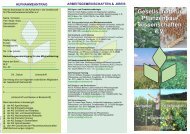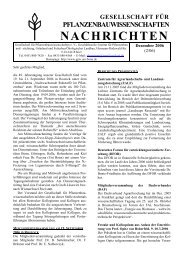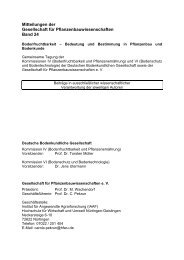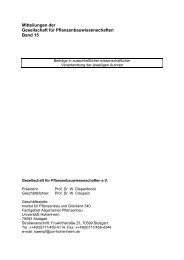Mitteilungen der Gesellschaft für Pflanzenbauwissenschaften Band 23
Mitteilungen der Gesellschaft für Pflanzenbauwissenschaften Band 23
Mitteilungen der Gesellschaft für Pflanzenbauwissenschaften Band 23
Erfolgreiche ePaper selbst erstellen
Machen Sie aus Ihren PDF Publikationen ein blätterbares Flipbook mit unserer einzigartigen Google optimierten e-Paper Software.
Mitt. Ges. Pflanzenbauwiss. <strong>23</strong>: 61–62 (2011)<br />
Comparative analysis of spatio-temporal patterns of carbon and<br />
water fluxes in production fields of winter wheat and sugar beet<br />
Moritz Kupisch 1 , Matthias Langensiepen 1 , Mark van Wijk 2 , Anja Stadler 1 and<br />
Frank Ewert 1<br />
1 Crop Science Group, Institute of Crop Science and Resource Protection, Faculty of Agriculture, University<br />
of Bonn; 2 Plant Production Systems Group, Wageningen University. E-Mail: mkupisch@unibonn.de<br />
Introduction<br />
Assimilation and transpiration are important processes affecting crop growth and<br />
yield. Modelling growth and water transport at the field scale should therefore<br />
consi<strong>der</strong> the spatio-temporal variability of these processes.<br />
Up-scaling gas-exchange from leaf to field is a particular challenge, because<br />
heterogeneities in soil and microclimate invoke distinctive regulation mechanisms<br />
that become apparent at the canopy level causing heterogeneities in gas fluxes. The<br />
purpose of this study was to analyze gas exchange at the point scale in a winterwheat<br />
and sugar beet crop, both at leaf and canopy levels, and to use spatial<br />
integration to characterize assimilation and transpiration at the field level.<br />
Material and Methods<br />
Measurements were carried out between May and October 2010 near Selhausen<br />
(50.868° N, 6.451° E), located in the Rur-catchment of North-Rhine-Westphalia. The<br />
wheat and sugar beet fields have each a gradient of two meters in the direction SE –<br />
NW, with sandy loam in the upper part and clayey silt in the lower part. Three<br />
measuring locations were chosen in each field which represent ranges including the<br />
extremes of soil properties and topography. Transpiration and CO2-assimilation were<br />
measured alternately at leaf and canopy level with a LI-6400 XT gas exchange<br />
analyzer (Licor Biosciences). Leaf-level measurements were carried out in the<br />
regular open path chamber cuvette mode. Canopy gas-exchange was measured with<br />
a closed Plexiglas chamber on a 1 × 1 m ground area with height adapters and using<br />
a custom protocol to monitor concentration changes with the sample IRGA at one<br />
second intervals. Gas-exchange was <strong>der</strong>ived by fitting quadratic and saturation<br />
functions to measured trends in gas concentration changes of CO2 and H2O,<br />
respectively, and taking the slope of these functions at t=0 seconds for calculating<br />
flux rates. Determination of leaf area index was conducted by using a PARceptometer<br />
(AccuPAR LP-80). Carbon and nitrogen contents of sunlit and shaded<br />
leaves were also measured.<br />
Results and Discussion<br />
Temporal and spatial variabilities were small for leaf photosynthesis and transpiration<br />
in both crops. Distinct daily patterns were not observed, except during severe hot and<br />
dry days when rates declined in the afternoon. Leaf nitrogen content in wheat was<br />
equal at all locations until the end of flowering, ranging from 4 to 5%. Increasing<br />
differences in leaf nitrogen between stressed (1%) and unstressed (3%) plants were<br />
observed towards the end of the season. In beet leaves, the differences in the field<br />
were higher at the beginning (values between 3 and 5%) but decreased until the end<br />
(all around 5%).







